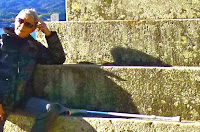 |
Saturday, December 21, 2013
Friday, December 13, 2013
Orange and Blue Aurae
One thing leads to another and I recently got into a discussion of auras with a friend of mine who is also interested in the phenomenon of energy waves emanating from, for want of a better expression, the spirit body.
I once had an interesting experience on a beach in West Africa. It was late afternoon and the setting sun was at just the right angle to create a field of sparkling light and shadow on the surface of the sea. I was relaxing with some friends and smoking some pot when I noticed a man walking along the water's edge and, as he passed between the sun sparkle and my line of vision, he seemed burst into a bluish glow that enveloped his entire body and seemed to flame over his head; it was a little something like watching a campfire--mellow and mesmerizing. I assumed it was an effect of the the pot and the sunlight and I expected it to die out as the man's silhouette moved out of the sun sparkle field of bright back lighting, but, instead, the aura held steady as he walked down the beach and eventually out of sight.
I recently ran across a little test that purports to tell you the color of your aura. I took the test expecting my aura to be blue, my favorite color, but to my surprise it turned out to be orange. That got me thinking that maybe we don't just have one aura, but that it can change according to different variables instead of being something fixed and unchangeable. Who knows what mysterious things we are capable of?
This is the link to the aura quiz if you're interested in trying on the color of your own aura.
What's the color of your aura?
Here's an impression of my own aura--as I thought it would be and as it actually turned out.
I once had an interesting experience on a beach in West Africa. It was late afternoon and the setting sun was at just the right angle to create a field of sparkling light and shadow on the surface of the sea. I was relaxing with some friends and smoking some pot when I noticed a man walking along the water's edge and, as he passed between the sun sparkle and my line of vision, he seemed burst into a bluish glow that enveloped his entire body and seemed to flame over his head; it was a little something like watching a campfire--mellow and mesmerizing. I assumed it was an effect of the the pot and the sunlight and I expected it to die out as the man's silhouette moved out of the sun sparkle field of bright back lighting, but, instead, the aura held steady as he walked down the beach and eventually out of sight.
I recently ran across a little test that purports to tell you the color of your aura. I took the test expecting my aura to be blue, my favorite color, but to my surprise it turned out to be orange. That got me thinking that maybe we don't just have one aura, but that it can change according to different variables instead of being something fixed and unchangeable. Who knows what mysterious things we are capable of?
This is the link to the aura quiz if you're interested in trying on the color of your own aura.
What's the color of your aura?
Here's an impression of my own aura--as I thought it would be and as it actually turned out.
Thursday, December 12, 2013
Getting Reacquainted 3 - Miyajima the Second Day
| the Great Torii and Itsukushima Shrine from our ryokan room at dusk |

By way of introduction, Japan's original “religion” is a kind of nature worship wherein everything has spirit or, if you like, soul. It resembles the animism of more primitive groups that I had the very good fortune of witnessing during the two and a half years I lived in West Africa. There the ceremonials appealed to the gut, with the throb of drums and wild dances and drugs, whereas here it is more refined, with the headier music of the flute flowing above the beat of the drums.
Around the 6th Century A.D., Buddhism was introduced into Japan through the Korean Peninsula and a syncretism of Buddhism and the more primitive Shinto occurred over the next few centuries. Writing was also introduced into Japan from China at this time and an amalgam of the two cultures evolved that created the Japanese society that we witness today.
 |
| tatami mat room of the inn |
| view of the torii from our inn room |
 |
| me and my trusty crutch |
| Sanmon (Main Gate) of Daishoin Temple |


The guardian gods of the temple symbolize the beginning and ending of all things. The statue on the right is called Agyozo and his open mouth symbolizes the birth of all things while the one of the left, Ungyozo, with his closed mouth symbolizes the ending.
| why I decided to bring my crutch |
| pilgrims will climb the mountain draped in fog |
| two pilgrims blowing on a conch shell horn that makes a haunting eerie sound as they climb through the fog and mist |
| the Maniden - a two-step pagoda |
| mani guruma - prayer wheels leading up to the Maniden |
| beautiful woodwork and fantastic wood carvings |
| 1000 Bodhisattvas - but you can't see them all in this photo |
 |
| unusual white paint tipping the ceiling beams |
| red maple |
Thursday, December 5, 2013
Getting Reacquainted 2 - Miyajima Day One
| the Great Gate (torii) and Itsukushima Shrine |
| the Setonaikai - the Inland Sea |
As I mentioned in my previous post, we decided to get reacquainted with Japan since we are not going to travel abroad for a while. Accordingly, we visited Miyajima not far from the city of Hiroshima recently. Miyajima is one of Japan's three celebrated beauty spots and a visit to this World Heritage Site will show you why. The site is not only one of a rare natural beauty, it is also a sacred place appropriate to the animism that inspires Shintoism, the ancient religion of Japan. The site is an exuberant celebration of the spirit that imbues the natural world with supernatural overtones. At high tide, and especially during the monthly lunar flood tides, the 厳島神社 Itsukushima Shrine and its attendant Torii seem to float in the space where sea and mountains meet.
 The road along the waterfront is well tended and landscaped and
full of deer. The deer are wild but do not fear people and can be
quite bold. As I was taking a photo one rather large fellow came up
behind me and started chewing insistently on my backpack and had to
be persuaded to reluctantly take a hike. As you walk along toward the
vermillion colored torii a breathtaking 5-story
vermillion colored pagoda appears above the houses on your left. But,
soon, you round a bend and the full glory of the torii
and the shrine precinct come into view. The rest is just point your
camera almost anywhere and take far too many pictures, of course.
The road along the waterfront is well tended and landscaped and
full of deer. The deer are wild but do not fear people and can be
quite bold. As I was taking a photo one rather large fellow came up
behind me and started chewing insistently on my backpack and had to
be persuaded to reluctantly take a hike. As you walk along toward the
vermillion colored torii a breathtaking 5-story
vermillion colored pagoda appears above the houses on your left. But,
soon, you round a bend and the full glory of the torii
and the shrine precinct come into view. The rest is just point your
camera almost anywhere and take far too many pictures, of course.
 |
| 大鳥居 [Great Gate] |
* The original torii was built in 1168, but the current incarnation of the gate was refurbished in 1875. Known as the 大鳥居 [Great Gate] it is about 16 meters high and made of decay-resistant camphor wood. The gate is not embedded in the sea bottom, but rests of its own weight and balanced by its supports on the sea bottom.
| wedding party |
| shrine buildings and torii at low tide - during the lunar neap tides (low lows) the torii is completely high and dry |

| the harmonious and contrasting colors make the scene look like a painting |
Saturday, November 30, 2013
Getting Reacquainted
 |
| Korakuen -- one of Japan's Three Great Gardens |
| autumn chrysanthemums |
| our municipal auditorium near Korakuen Garden |
| cake shop along our walking tour |
 |
| Asahi River and autumn pampas grass |
 |
| crow sitting on the roof of Ujo (Crow Castle) |
 |
| teahouse garden |
| main gate of Okayama Castle |
 |
| secondary gate |
| a poem by the Emperor on a visit to the Ujo -- the Kanji 烏城 can be seen at the top of the 3rd column from the right |
Saturday, November 23, 2013
Monday, November 18, 2013
Subscribe to:
Posts (Atom)


